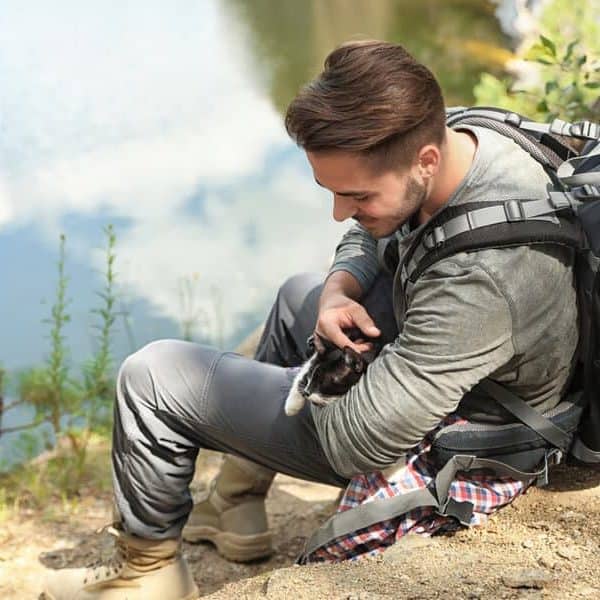There’s nothing better than traveling with your pets. But nothing would be worse than having your dog or cat get lost while they’re away from home. Sadly, each year a number of pets run away while they’re on vacation with their families.

We want to make sure that when you travel, you and your furry family members all come home together! So today we’re sharing what we’ve learned from years of traveling with our dogs. Follow these tips and you should never have to worry about your pet getting lost while traveling.
Make Sure Your Pet Doesn’t Get Lost While Traveling
1. Adjust your pet’s collar to fit correctly.
A properly fitted collar should be snug around your dog or cat’s neck, allowing just enough room for you to slip two fingers underneath. Collars that are too loose can slip over your pet’s head if they suddenly shift into reverse. Also, check the buckle for wear and replace the collar if necessary. After all, the ID tag on a lost pet’s collar is his first line of defense!
If you think your dog may be uncomfortable with a collar fitted that tightly, consider a martingale collar. This type of collar has no buckle to wear out, and has a built-in loop that tightens when your pet pulls on the leash.
Martingale collars should be adjusted so at it’s tightest point, you can just slip two fingers beneath it. When his leash isn’t attached, the collar will fit loosely around your dog’s neck. But he won’t be able to back out of his collar if something frightens him.

2. Leave your pet’s collar on.
Taking your pet’s collar off while they’re lounging around the house or heading to bed at night is a habit best left at home. When you’re traveling, it’s safer to leave your pet’s collar (and therefore, identification tags) on at all times … just in case.
3. Check your leashes.
A simple way to keep your pet from getting lost while traveling is to check your leashes. Like everything else, leashes wear out and need to be replaced – especially if your pup thinks it’s a chew toy!
Check the latch regularly to be sure the spring is operating properly, and examine the entire leash for damage. This is especially important for people who use retractable leashes, because it’s hard to notice wear and tear. Once a month attach your leash to something stationary, walk back to the point where the leash is fully extended, and give it a good tug – at least twice as hard as your dog would pull in pursuit of a squirrel. If it snaps, you’ll know it’s time for a new one!
4. Get a harness for your pet.
One of the benefits of harnesses is that they provide some extra security. It’s a lot harder for a cat or dog to wiggle out of his harness than it is for him to slip his collar!
READ MORE ⇒ Choosing The Best Cat Harness Cat

5. Be mindful of how you hold the leash.
Walking pets requires dexterity! When you’re juggling multiple leashes, a handful of treats, and a waste bag in search of the proper receptacle, it’s easy to get careless with your grip on the leash. And that’s usually the moment your dog chooses to hit the brakes and check his p-mail!
Slipping your hand through the handle, so the loop rests around your wrist, and then grabbing the leash, gives you a better grip if your pet makes an unexpected move.
Of course, taking care that you don’t drop the leash is especially important if you’re using a retractable leash. Imagine how your pet would feel seeing that handle flying toward him on a collision course!
For retractable leashes, consider tying a piece of ribbon or string though the handle and using it as a safety loop around your wrist while you’re using the leash.
6. Develop a routine for getting pets in and out of the car.
You may think that once your pet is in the car, he’s safe. But what if someone opens the door on the other side of the vehicle and your pal scoots out before you’ve secured his seat belt?
When it’s time to leave, put your pet in the car, fasten his seatbelt or get him in his carrier, and then remove his leash. When you arrive, reattach his leash before removing him from the carrier or unbuckle his seatbelt harness. This procedure applies for all stops – including breaks at rest areas along the way.
READ MORE ⇒ The Ultimate Pet Friendly American Road Trip

7. The routine for the car also works well in hotels!
Clip your pet’s leash on before you open the door of your hotel room. Even if you’re just putting out your “Do Not Disturb” sign or asking housekeeping to come back later.
Pets are naturally curious about what’s going on in the hallway, and you don’t want yours taking off to check it out by himself!
8. Skip the off-leash playtime.
Your dog might come to you every time you call him in your back yard. But with new sites to sniff and friends to make, it’s possible his recall won’t be as reliable away from home.
If you have a big dog who really needs some space to exercise, look for a fenced, off-leash dog park. Or get a long-line leash that will allow him to play, without the danger of getting lost.
9. Sometimes you have to fight your instincts.
To keep your pet from getting lost while you’re traveling, you might have to fight your instincts. If your pet somehow gets away from you, do not panic. Think quickly — can take a few quick steps and grab the leash? Do it! But, if your pet is running away from you, fight the urge to chase him.
The best thing to do when your pet is running away is to stop, drop to the ground, and lie there calling his name. First of all, running bent over trying to catch your pet is nearly impossible. I speak from experience. But worse than potentially injuring yourself, chasing your dog or cat might only encourage him to keep running — potentially into a life-treating situation. This wonderful article by Mel at No Dog About It explains why you should never chase a lost dog.

10. Hope for the best, but plan for the worst.
Sometimes, you do everything right and bad things still happen. If your pet does somehow become lost while you’re traveling, you’ll have a much better chance of getting him back if you’re prepared.
- — Make sure your pet’s ID tag is up-to-date and has a phone number where you can be reached while you’re traveling. Digital ID tags include an online profile for your pet, so you can update your contact information for every trip you take, as well as provide medication requirements, personality traits, and vaccination records for your pet.
- — Have your pet micro-chipped, so he can be identified if his collar breaks or his ID tags are lost.
- — Reach out to every shelter, animal rescue, dog pound, and veterinarian in the area to inform them that your pet is lost and send them a photo.
- — If you have friends or contacts in the area, ask them to share the information about your pet with their social media network.
With a little vigilance and preparation, you can make sure that your next pet friendly vacation is fun for everyone. And that you all come home safely together.









I would urge anyone using a martingale collar to use one that has a buckle so you can get the collar off quickly if you need to. My dog got her paw through the martingale loop on her collar and the loop slipped up her leg as she struggled to get free, sending her into a panic as she choked with the tightening collar. If the collar hadn’t had a buckle it would have been much harder to get the collar off and free her.
Thanks for sharing your experience, Paula! That’s something I never would have considered, but it’s exactly the reason that being part of this community makes us all better pet owners. Thanks again!